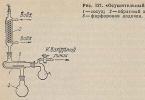Attention : It is not allowed to fill the cooling and heating system of NEFAZ buses with coolants of different brands and manufacturers, as well as liquids that do not comply with the chemmotological card ( ), to determine corrosion of system elements.
At each TO-1 and TO-2, check the density of the liquid and monitor coolant samples from the heating system for compliance with the requirements of the specifications (alkalinity and hydrogen index) with a mark in the service book. If there is a discrepancy, replace the coolant.
If these requirements are not met, claims for failure due to corrosion of heating system elements will not be considered by the bus manufacturer.
Note . Copies of passports describing the design and maintenance of heaters of models A1-205.241.251 and A2-21.243.252.314, intended for heating the driver’s seat and passenger compartment, are given in .
Bus interior heating produced from the engine cooling system. To the engine cooling system ( see Figure 216 - Diagrams of the operation of the heating and engine heating system on city buses (with three COs), on suburban buses (with four COs) and on intercity buses (with six COs) and Figure 217 - Installation diagram of the damper and air separator in the bus interior heating system) includes: liquid heater, pipelines, pump, damper, air separator, drain valve, air release valves, valves No. 1, No. 2 and No. 3, shown in the mentioned diagrams. The arrows indicate the direction of fluid circulation in the system.
Figure 216 - Schemes of operation of the heating and engine warm-up system on city buses (with three COs), on suburban buses (with four COs) and on intercity buses (with six COs)
PZD - heater; FO - front heater; CO - cabin heaters; N - pump PZD; Kp1 - Kr3 - system taps; M - electric motors; VO - air separator; D - damper; K - air release valves; KS - coolant drain valve; RB - expansion tank

Figure 217 - Installation diagram of the damper and air separator in the bus interior heating system
1 - damper; 2 - air separator; 3 - tap Kr.2 (red); 4 - tap Kr.1 (blue); 5 - tap Kr.3 (black); 6 - coolant drain valve (KS); I - to the interior heaters; II - outlet from the heater; III - fluid supply from the system; IV - air outlet from the system into the engine expansion tank; V - outlet to the water pump; VI - supply from the heater; VII - removal of heated fluid to the engine
Heating system works like this:
- for accelerated engine heating without interior heating - open tap No. 1 and close taps No. 2 and No. 3;
- when heating the interior from the engine and heater, close tap No. 1 and open taps No. 2 and No. 3;
- when heating the interior from the engine, without turning on the heater, close tap No. 1 and open taps No. 2 and No. 3;
- when operating the bus in the summer, open valve No. 1 and close valves No. 2 and No. 3;
- prohibited operating mode of the system is to open valve No. 2 and close valves No. 1 and No. 3.
The heating system that heats the driver's workplace consists of a pass-through valve, pipelines and a front heater mod. A2-21.243.252.314 (Passport A2-01N.000.000 PS).
A car heater consists of two main blocks: heating and fan.
The heating block consists of a double aluminum radiator and housing. The body has six outlet pipes 4 ( Figure 218 - Air intake adjustment) with a diameter of 72 mm.

Figure 218 - Air intake adjustment
1 - bus bumper; 2 - louvered damper; 3 - heating and fan heater blocks; 4 - exhaust pipes; 5 - louvre damper adjustment lever
The fan unit includes two radial fans, a cover and an air intake control mechanism. To remove air bubbles in the heating system, there are air release valves and a centrifugal air separator (in Figure 216 - Schemes of operation of the heating system and engine heating on city buses (with three COs), on suburban buses (with four COs) and on intercity buses (with six COs) The arrow shows the direction of circulation of the working fluid).
The damper is designed to smooth out pressure surges in the working fluid in the heating system.
The design of the heater allows air intake from outside the bus or from the driver's cabin, due to regulation by louvered damper 2 (see Figure 218 - Air intake regulation) located on the front heater radiator.
Lever 5 regulates the position of the louvre damper using a cable connection. When lever 5 is pressed upward, the louver flap rotates along its axis and, by its movement, opens the flow of air from outside the bus (recirculation mode).
The air heated in the front heater is directed through a system of air ducts to the air supply box (on the driver's instrument panel), and from it through the air blowing holes onto the windshield and into the niche, to the driver's feet and the front door leaf. In the reverse position of the damper, heated air is drawn into the heating system from the driver's cabin. The stroke of the louver damper is 55 mm.
The heating system that heats the bus interior consists of pipelines and three dual-mode heaters located inside the podiums of the wheel arches. Interior heaters are radiator type with forced air supply by electric fans through radiators. The same heater is installed in the cabin under the driver's seat. The heaters are connected in parallel to each other and connected to the engine cooling system.
To remove air bubbles in the heating system pipes, there are air release valves behind the driver's partition in the passenger compartment.
The heating system of the bus interior provides for the installation of a centrifugal air separator 2 ( see Figure 217 - Installation diagram of the damper and air separator in the bus interior heating system) - to remove air from the system, and install damper 1 - to eliminate hydraulic shocks in the system (to smooth out surges in pressure of the working fluid in the system).
Attention . To avoid water hammer, it is strictly forbidden to switch the heating system taps while the engine is running.
Ventilation bus can be carried out in a natural or forced way. Natural ventilation of the bus is carried out through air intakes located in the front part under the windshield, emergency ventilation hatches in the roof and through vents in the side windows. Forced ventilation is provided by four ceiling electric fans (installed as an option) and a rotary electric fan installed in the driver's office.
Ventilation of the driver's workplace is carried out through the movable glass of the side window. The ventilation intensity can be increased by turning on the front heater fan in recirculation mode ( see above).
The interior is ventilated through vents in the side windows and emergency ventilation hatches in the roof of the bus.
LiAZ, PAZ and LAZ buses have a heater system for heating the body. The heat from the engine cooling system is used for heating. The air pumped by the fan passes through the radiator, is heated here and enters the air duct located along the entire body. From the air duct, through the cracks in it, air flows evenly throughout the entire cabin.
The amount of air entering the cabin through the air duct is regulated by a handle that controls the position of the duct damper. In the summer, when there is no need to heat the interior, the handle must be placed in the extreme forward position. In this case, the flaps will close, and the lower flap will open a hole in the bottom of the casing and air will escape into the engine compartment. With the dampers fully open, all the warm air will go into the cabin. If the dampers are in an intermediate position, the air flow into the cabin will decrease. The heating system of buses ensures air exchange in the cabin every minute.
Ventilation of the interior of LiAZ and LAZ buses is carried out through opening vents of the side windows, through an air intake from under the visor, through opening hatches in the roof of the bus. Opening and closing of hatches is carried out by lever-type lifting mechanisms.
Heating of the driver's cabin is regulated by a damper. For windows, warm air is supplied from the heating system through hoses.
On LAZ-695M and LAZ-695N buses, the air channel ends at the front wall of the body, where two fans are installed in a special casing, which capture air and create pressure in the glass blowing nozzles. Fans and nozzles are connected by hoses. To regulate the supply of warm air depending on the ambient temperature, there are two dampers: bottom and side. If these dampers are closed, the warm air is discharged outside through the lower window with the damper.
When operating a bus in the cold season (at temperatures below - 10°C), in order to avoid engine overcooling, the fan shutters are closed and warm air is directed through a small circulation circle. Air from the passenger compartment enters the radiator, is heated and returns to the passenger compartment through a channel through open valves.
Ventilation of the bus body is carried out through ventilation hatches, side windows, an air intake from under the visor, and a calorific heating system.
There is a similar heating system on PAZ buses. The body heating system of the Ikarus-260 bus, in addition to the engine radiator, has two additional devices: a heater for the windshield and the driver's cabin and a heating device for the interior.
Warm water from the engine passes through pipelines to the radiator of the interior heating device and the heater of the windshield and driver's cabin. The air pumped by the fan, passing through the radiator, heats up and then flows through the heater tube into the passenger compartment and into the driver's cabin to heat the windows. Fan switches have two fixed positions for heating control.
The heater heating system of the Ikarus-260 bus is similar in design to the system of domestic buses.
On some versions of Ikarus-260 buses, a Sirocco-type heating and ventilation device is installed. This device is autonomous and runs on liquid fuel.
PAZ-32053-07, PAZ-4234. HEATING SYSTEM
Heating of the bus interior and the driver's workplace is carried out by a liquid heating system that uses the heat of the engine cooling system and a liquid heater.
Interior heaters have two operating modes - full and partial.
They are controlled using two-position keys located on the instrument panel.
To effectively heat the interior and blow off windshields, it is necessary to maintain a sufficiently high temperature of the coolant in the engine cooling system and ensure circulation of the liquid through the pipelines, which is achieved by operating a liquid heater and circulation pump, which must be constantly on.
Webasto (Spheros) liquid heaters of the Thermo E200 and Thermo E320 models are installed on PAZ-32053-07 and PAZ-4234 buses, respectively.
Liquid heaters of the Thermo E200 and Thermo E-320 models are an autonomous heating system that operates independently of the engine. The heater is designed to maintain the temperature of the liquid (antifreeze) within limits sufficient to heat the interior, defrost windshields, and preheat the engine.
When the liquid in the boiler heats up to 85 °C, the heater automatically turns off. When the antifreeze cools to 72 °C, the heater turns on.
A description of the heater is contained in its operating manual, which is included in the delivery package of the bus.
Turning on and starting the heater.
When the heater is turned on, the operation indicator lights up, the control unit starts normal operation mode and checks the coolant temperature.
If the coolant temperature is below the upper temperature threshold, the pre-start phase begins. The combustion air blower and circulation pump are switched on. In about
12 seconds (pre-start time) a high voltage ignition spark appears. About a second later, a solenoid valve in the fuel pump opens and incoming fuel is injected through the high-pressure atomizing nozzle into the combustion chamber. In the combustion chamber, fuel is mixed with air. This air-fuel mixture is ignited by the ignition spark and burns in the combustion chamber. Flame control is carried out by a flame sensor built into the control unit. Approximately 5 seconds after recognizing the flame, the control unit turns off the pilot generator. Until this moment, the flame has stabilized and the heater is not yet in heating mode.
Operation in heating mode. After the flame has stabilized, the heater operates in normal operation mode. When the upper switching threshold is exceeded, operation in the heating mode ends and the purge phase begins. The solenoid valve closes and the flame goes out, but the combustion air blower and circulation pump continue to operate. After approximately 120 seconds, the combustion air blower is switched off and the purge phase ends. The heater stops (break in operation). The operation indicator is on. The heater resumes operation in combustion mode when the lower switching threshold is exceeded.
The same operations are performed as when turned on
the lower the switching threshold is set for the start of the work interruption. Restarting the burner after a break in operation is also carried out at a lower switching threshold. This prevents the overheating protection from tripping due to residual heat. If the temperature rise (temperature gradient) is again within the permissible limits, the switching thresholds are reset to the normal values (lower switching threshold 72 °C, upper switching threshold 85 °C).
Shutdown. When the heater is turned off, the combustion process ends.
The operation indicator goes out and the purge phase begins. The solenoid valve closes, the flame goes out, and the combustion air blower and circulation pump continue to operate. After approximately 120 seconds, the combustion air blower is switched off and the purge phase ends. If a problem occurs during the purge phase (for example, flame detection), the purge phase may last less than 120 seconds. During the purge phase, the heater is allowed to be switched on again. After a purging phase of 30 seconds and a subsequent pre-start phase, the burner starts again.
Operating and Maintenance Instructions
Attention! Maintenance and repair of the heater must be carried out by qualified specialists who have undergone in-house training at the heater manufacturer (Spheros and Webasto).
Before opening the heater, it should be disconnected from the on-board network of the bus. The heater should always be disconnected from the bus electrical system before disconnecting the temperature sensor plug. Carrying out the disconnection in the reverse order results in AUTOMATIC LOCKING of the heater. Before disconnecting the burner from the heat exchanger, disconnect the temperature sensor plug.
The temperature in the heater area must not exceed 85 °C (maximum operating temperature). Exceeding the temperature may cause heater malfunction and irreversible damage to electronic equipment.
It is prohibited to use the heater without exhaust gas extraction in enclosed spaces (garages or workshops), even if the time has been preset, due to the risk of poisoning and suffocation. This also applies to operation in combustion mode when adjusting the CO2 indicator in the exhaust gases.
Do not operate the heater near flammable materials (leaves, dry grass, paper, cardboard, etc.).
When operating without coolant (overheating!) the heater casing may reach the ignition temperature of diesel fuel! Dripping or evaporating fuel should neither collect nor ignite on hot parts or electrical devices.
The air intake and exhaust pipe openings must be checked regularly and cleaned if necessary.
At gas stations and refueling installations, the heater should be turned off due to the risk of explosion.
In places where flammable vapors or dust may form (for example, near fuel, coal and wood dust, granaries, etc.), the heater should be turned off due to the risk of explosion.
The coolant in the heating circuit must contain at least 20% antifreeze.
When carrying out electric welding work on a bus, to protect the heater control unit, it is necessary to disconnect the main electrical cable (plus) from the battery and ground it to the body.
In case of deviations from normal operation, the heater is automatically blocked.
There are two types of heater blocking - emergency blocking in case of malfunctions and blocking.
The interlocks are designed to protect the heater from damage primarily due to unacceptable thermal loads. Thermal loads can arise for the following reasons: a) the coolant circulation rate is too low; b) insufficient amount of coolant (dry overheating); c) failure of the circulation pump.
When the heater is blocked, depending on the time of occurrence, the purge phase can last up to 120 seconds. The reason for the blocking can be determined using the indicator's flashing pulses.



